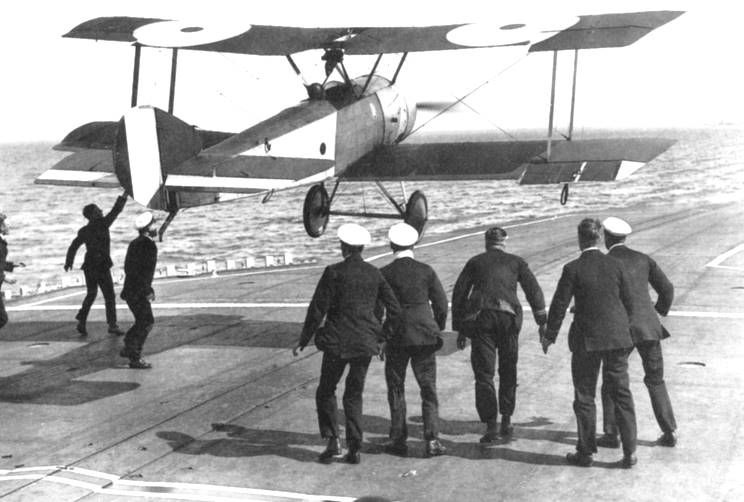|
In the early part of the 20th century naval aviation was in its infancy. At first aircraft were used as observation platforms only, this was due to the limited duration of flight and the low power of the machines. Not being able to carry weapons aircraft were seen by the navy at least, as something of limited use. As with any new technology there are those who don't understand what progress will bring. Every human endeavor progresses over time, but to progress usually requires sacrifice. The first ever take off from a ship was made by Eugene Ely, an American, who took off from a platform built on the foredeck of USS Birmingham, this was on Nov. 14, 1910. In January of the following year he made a landing on USS Pennsylvania, both ships were at anchor. The first ever underway takeoff was made by Cdr. Charles Sampson from a platform built on HMS Hibernia. It was not until August of 1917 that a pilot was able to take off and land on a moving ship. The battlecruiser HMS Furious, like several other ships, had flight decks built, but was in no way what you would call an aircraft carrier. This nevertheless was the ship on which Squadron Commander Edwin Harris Dunning, D.S.C., R.N.A.S. took off from on Aug. 2, 1917. Five days later on August 7, 1917 he took off and successfully landed on the moving ship. However, he decided to repeat his efforts and make a second take off and landing. The take off was successful, but on landing an updraft caught his aircraft, the tail hook missed and his Sopwith Pup went off the end of the ship. Blown to the right at the end of the flight deck, his plane crashed into the sea. Unable to extricate himself from the plane, he drowned before he could be rescued. His body was recovered and he was buried at St. Lawrence's Church in Bradfield. Inside the church there is a plaque, it states the following: "The Admiralty wish you to know what great service he performed for the Navy. It was in fact a demonstration of landing an Aeroplane on the deck of a Man of War whilst the latter was under way. This had never been done before, and the data obtained was of the upmost value. It will make Aeoplanes indispensable to a fleet and possibly, revolutionise Naval Warfare. The risk taken by Squadron Commander Dunning needed much courage. He had already made two successful landings, but expressed a wish to land again himself, before other Pilots did so and in this last run he was killed. My Lords desire to place on record their sense of the loss to the Naval Service of this gallant Officer." |
© 2012 Michael W. Pocock MaritimeQuest.com |
 |
Squadron Commander Edwin Harris Dunning, D.S.C., R.N.A.S. seen just seconds before his Sopwith Pup went off the flight deck into the sea. |